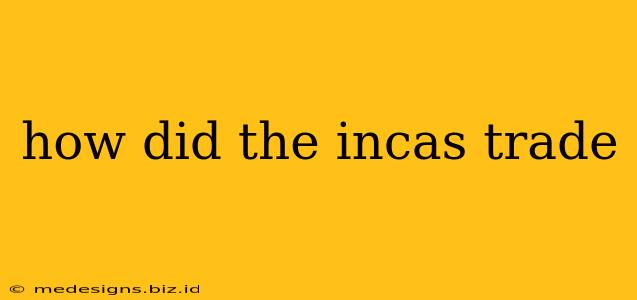The Inca Empire, a civilization that flourished in the Andes Mountains of South America from the 15th to the 16th centuries, possessed a remarkably sophisticated and complex trading system. Unlike many other empires relying heavily on monetary exchange, the Inca economy thrived on a unique blend of state control, reciprocal labor (mita), and a sophisticated system of redistribution. Let's delve into the intricacies of how the Incas conducted trade.
The Absence of Currency: The Mit'a System and Redistribution
Unlike many societies that used currency, the Inca Empire didn't have a formal monetary system. Instead, they relied heavily on reciprocity and the redistribution of goods. This intricate system was managed by the state, ensuring the flow of resources throughout the vast empire.
The Mit'a System: Labor as Currency
The mit'a system was a crucial component of the Inca economy. It was a form of mandatory labor service where citizens were required to contribute a certain amount of work to the state. This work could involve anything from building infrastructure like roads and temples to agricultural activities on state-owned lands. The mit'a wasn't just about labor; it provided access to essential resources and services in return. In essence, it served as a kind of currency, albeit one based on labor rather than coins or precious metals.
Redistribution Networks: The State's Role
The Inca state played a central role in the distribution of goods. Collected goods, surpluses from state-owned farms, and goods produced through the mit'a system were stored in vast warehouses called qollqas. These warehouses acted as central hubs, ensuring the availability of necessities throughout the empire. During times of scarcity, or for specific projects, these goods were redistributed to the population. This system effectively minimized famine and ensured a degree of economic stability across diverse regions.
Trade Routes and Networks: The Inca Road System
The Incas possessed an incredibly impressive road system, a crucial component of their trade infrastructure. These roads, often paved and meticulously maintained, stretched thousands of miles, connecting different parts of the empire. This infrastructure facilitated the movement of goods, people, and information, strengthening both internal trade and communication.
Relay Runners and Transportation: Efficient Logistics
Efficient transportation of goods relied on a network of relay runners, chasquis, who carried messages and smaller goods along the extensive road network. This system ensured swift communication and the movement of vital information. For larger or heavier goods, llamas were crucial pack animals, carrying goods over the challenging Andean terrain. The system was strategically organized, ensuring goods could reach their destinations relatively quickly and efficiently.
Specialized Production and Exchange: Regional Differences
While the state controlled much of the economy, regional specialization existed. Different regions excelled at producing specific goods. For example, some areas were known for their textiles, others for their pottery, while still others focused on agriculture. This specialization fostered exchange between regions, contributing to the overall economic stability.
Beyond Redistribution: Limited Market Exchange
While the state-controlled redistribution was paramount, limited market exchange did occur, especially in urban centers. These exchanges were typically for non-essential goods or luxury items that weren't part of the state's redistribution network. However, the extent and nature of this market exchange are still debated by scholars.
Conclusion: A Unique Economic System
The Inca trading system was a remarkable blend of state control, reciprocal labor, and redistribution, operating without a traditional monetary system. The impressive road infrastructure, the mit'a system, and the strategic placement of qollqas ensured the efficient flow of resources throughout the vast Inca empire. While limited market exchange existed, the Inca economy fundamentally differed from systems reliant on currency, showcasing a unique and innovative approach to economic organization. Studying the Inca economic system provides valuable insights into alternative models of resource management and societal organization.
